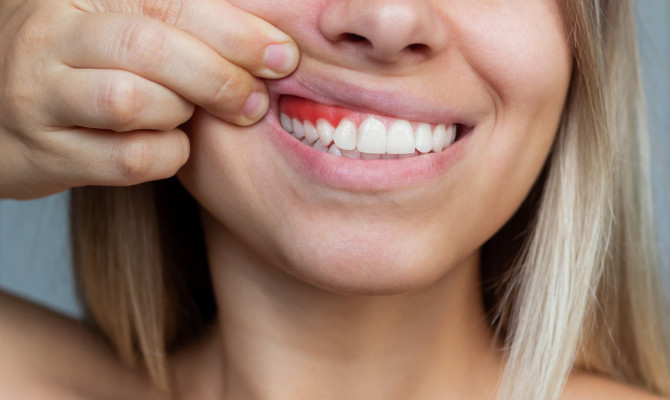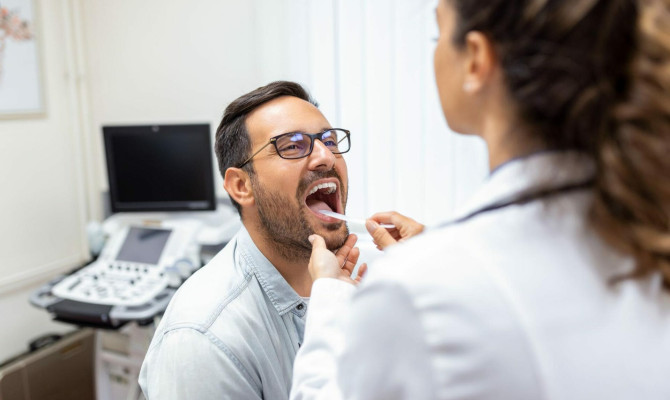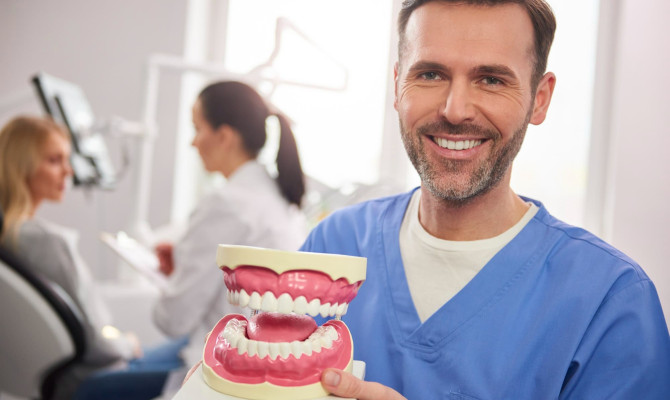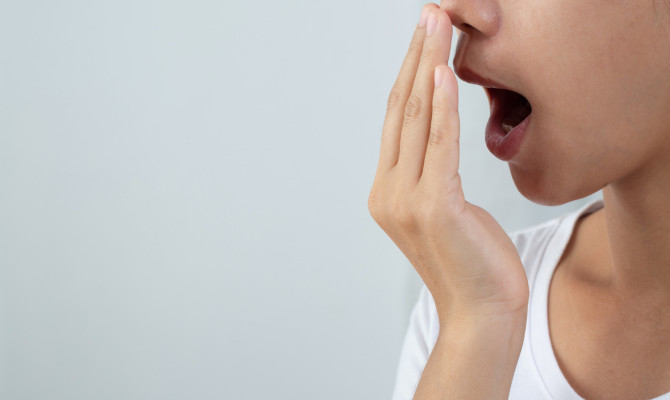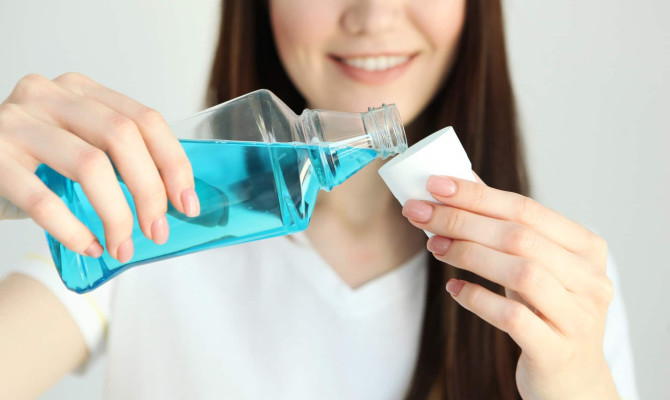How To Floss With Braces: Techniques & Tips

- Flossing
- 04 Oct 2023
Overview
Floss With Braces
It is not difficult to learn how to clean your teeth while wearing braces, but it can be a real trouble to do it correctly every day. Regular floss works just well, but threading it through and out of the area beneath the arch wire makes the procedure much more difficult and time-consuming. Thankfully, there are several unique devices available that make flossing simpler. These consist of:
- Floss threaders
- Specially designed floss picks
- Dental floss that is partially rigid
- Water flossers that contain tips for braces. 2 Overview| Researched based study from Dentaly
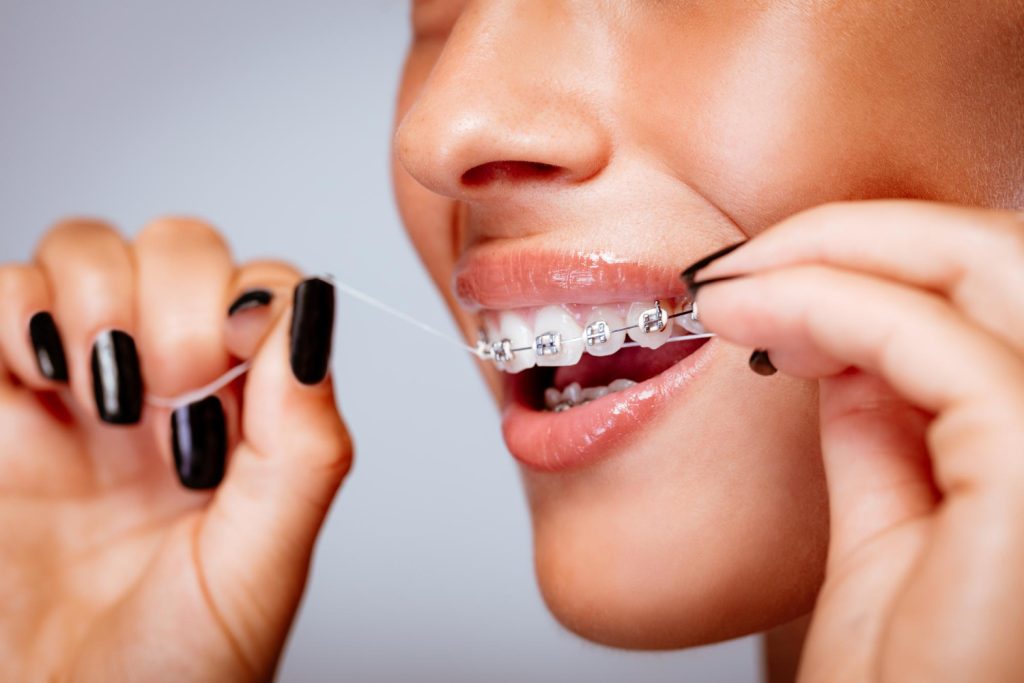
Basics
What is Flossing?
- Waxed or unwaxed, single-stranded, or multi-stranded dental floss is available.
- Waxed monofilament floss works best for braces because it slides around them more smoothly and is less prone to snag or become trapped.
- Daily flossing is also crucial.
- Dental floss threaders can be used to guide the floss through gaps between the teeth, brackets, and wires.
- As an alternative to standard floss, interproximal brushes can fit beneath the arch wire.
- Oral irrigators or flossers with water can also be used to remove debris, and fluoride rinses with anti-cavity properties offer further security. 5 Basics| Researched based study from Mayo Clinic
Floss With Braces
Different Ways to Floss With Braces on
- It may be quite unpleasant and tedious to try to thread the thin floss through each hole.
- Instead, to make the task simpler, you could decide to utilize an orthodontic floss threader.
- These needle-shaped tools feature a stronger point, which enables positioning the floss faster and simpler.
- They are constructed of flexible nylon, and they come with a handy, sanitary carrying bag that can be kept in a backpack for students who wish to floss after lunch or for travel.
- The proper usage of a floss threader is simple to master. Run the end of the tail and a portion of the loop straight beneath the arch wire.
- Add a few inches of floss then pull the knot the rest of its length through once it has advanced approximately halfway.
- When you are ready, draw the floss through and continue the process while cleaning in between the teeth as usual. 2 Flossing with Braces| Researched based study from Dentaly
Water flosser for braces
- If using traditional dental floss is too difficult for yourself or the child while wearing braces, consider utilizing an electric water flosser.
- These devices, also known as oral irrigators, look like electric toothbrushes but clean around teeth by releasing water with high pressure.
- Many well-known brands of water flossers are available for use along with the braces, that include Philips air floss, Waterpik, Jetpik, and cariPRO. These water flossers come in with a wide range of characteristics and functioning.
- Find one with a power level you can modify, especially if you plan to use it on your kid’s teeth.
- Since it does not have the same physical contact for scraping plaque off teeth as traditional floss does, it is still unknown if an oral irrigator is effective enough to use in place of that material.
- Water flossers are really more efficient than string floss, also it is absolutely something to consider as you could reduce plastic waste in your daily life. Another option that functions similarly is air flossers. 2 Flossing with braces | Researched based study from Dentaly
Advantages
What Advantages does Flossing Offer?
The advantages of flossing are:
- Dental plaque is removed and prevented
- Gum disease is prevented by flossing
- Being healthy requires good oral hygiene
- Flossing improves the efficiency of teeth brushing
- You can save money by flossing so your smile will stay clean. 4 Advantages| Researched based study from Our Good Living Formula
Dental plaque is removed and prevented:
- By using dental floss to clean in-between your teeth, you can reach regions that even an electric toothbrush cannot.
- Flossing stops plaque, a sticky film that builds on your teeth, from accumulating. Bacteria and carbohydrates make up plaque.
- Since it is continually developing and has no color, it may swiftly accumulate without your knowledge.
Gum disease is prevented
- You may lower your risk of developing gum disease by eliminating plaque from hard-to-reach places including in between the teeth and below the gum line.
Being healthy requires good oral hygiene
- Even though not all of the reasons have been identified, gum disease has also been connected to other disorders.
- Patients with diabetes who have diseased gums may find it more difficult to maintain their blood sugar levels than those who have healthy gums.
- Additionally, bacteria found in gum disease can induce or aggravate lung diseases, especially in elderly people.
- Poor dental health during pregnancy has also been associated with early deliveries, which results in lower birth weights for the offspring.
Flossing improves the efficiency of teeth brushing
- It is far better to brush and floss your teeth together than to merely brush them.
- According to dentists, the ideal time to floss the teeth is just before brushing them.
You can save money by flossing
- You may avoid gum disease and cavities by using the prescribed amounts of floss and mouthwash, brushing and flossing your teeth on a regular basis, and seeing the dentist frequently. 4 Advantages| Researched based study from Our Good Living Formula
Importance
What is the Importance of Flossing?
- Gingivitis, the first stage of gum disease, can be prevented by practicing basic oral care.
- Gum disease symptoms might include poor breath, red, puffy, and sensitive gums, as well as bleeding and swollen gums.
- Cleaning your teeth with braces is more time and labor-intensive since the wires and brackets obstruct a toothbrush and floss from doing their job directly.
- When brushing your teeth while wearing braces, make a 45-degree angle with the toothbrush’s bristles pointed toward the gum line and gently move the toothbrush forward and backward to remove food particles and bacterial plaque.
- Next, brush on top of the brackets as well as underneath the brackets to remove plaque from this region and the elastics.
- Pay close attention to and be as thorough as you can with the gap between the teeth. 1 Importance | Researched based study from Illinois Department of Public Health
What happens if you do not floss?
- When you have orthodontic braces on, flossing is just as crucial.
- Without flossing, bacteria-filled plaque will accumulate along the gum line as well as between your teeth.
- This may ultimately result in issues including foul breath and periodontitis. 2 Importance | Researched based study from Dentaly
Avoid
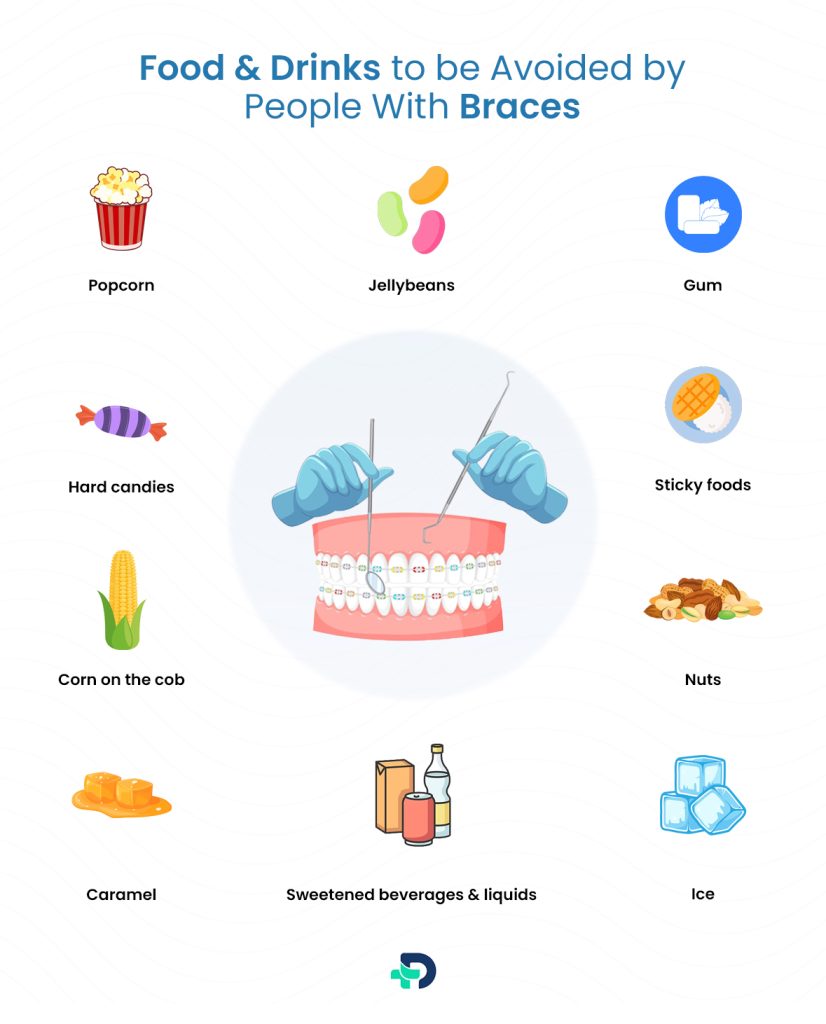
Food & Drinks to be Avoided by People With Braces
It is crucial for people with braces to eat healthily. Maintaining a balanced diet of wholesome foods with few between-meal snacks is advised.
- Popcorn
- Jellybeans
- Gum
- Hard candies
- Sticky foods
- Corn on the cob
- Nuts
- Caramel
- Ice
- Sweetened beverages and liquids. 1 Foods to avoid| Researched based study from Illinois Department of Public Health
FAQs
Floss With Braces – Frequently Asked Questions
Q. Can you floss normally with braces and when to floss?
- Patients must gargle their teeth completely before flossing.
- Their brushing approach should include all of the surfaces of each tooth, as food and plaque can get lodged between the brackets, wires, and between the teeth.
- Additionally, they should spend time concentrating on their front teeth and their braces while using a variety of motions, like side-to-side and circular movements, to remove any food and plaque.
- Food and plaque may get lodged, creating the ideal environment for bacterial growth.
- By passing this crucial procedure, you run the risk of developing gum disease, tooth decay, foul breath, and stained teeth. 3 FAQs | Researched based study from Orthodontics Australia
Q. Is it difficult to floss with braces?
- Food can quickly become trapped in your child’s braces.
- Throughout their treatment, it is crucial that they learn how to properly take care of their teeth, gums, and braces in order to preserve healthy teeth and gums.
- Learning to floss while wearing braces may seem challenging at first, but it does get simpler with experience. 3 FAQs | Researched based study from Orthodontics Australia
Q. Is it best to floss before or after brushing?
- To make sure that there are no lingering food particles or residue, floss after every snack or meal as well as immediately after eating. 3 FAQs | Researched based study from Orthodontics Australia
Q. Is it acceptable to skip flossing for a single night while wearing braces?
- With braces, you should brush more frequently, likely once after each meal but it is alright if you do not floss one night.
- With braces, plaque accumulation between teeth will not significantly change. 2 FAQs | Researched based study from Dentaly
Q. How much time does flossing take with braces?
- We are aware that flossing takes longer than you would like, especially if your appliance is in the way.
- You could discover that using waxed floss, a floss threader, or even an interdental toothbrush makes the work go more quickly and easily.
- Whatever strategy you use, as long as you are diligent and meticulous, it really does not matter. 3 FAQs | Researched based study from Orthodontics Australia
Q. Can I use water floss instead of floss with braces?
- It is extremely important to keep braces very clean. With a water flosser, you may easily clean up after each meal.
- Patients who utilize a water flosser must still floss on a daily basis.
- This is due to the fact that floss can eliminate more dirt than the Waterpik.
- For the best results, use both normal floss and a water flosser. 2 FAQs | Researched based study from Dentaly
Conclusion
Flossing With Braces – Though Time Consuming But Worth Doing
Any of these are excellent options for flossing while wearing braces, and which one is ideal for you depends on your choices for cost, practicality, and reusability. A combination of one or more of these tools may turn out to be the best option for you. In the end, you could be better off switching to an interdental brush or maybe a water flosser instead of the pain of threading floss between the braces. These flossing techniques for braces are undoubtedly preferable to not flossing at all, and in the case of interdental brushes, they may even be superior. 2 Conclusion | Researched based study from Dentaly
Any feedback on this article?
 This Articles content was accurate
This Articles content was accurate Very Informative Article
Very Informative Article I have a question or a comment
I have a question or a comment
 This article contains inaccurate content
This article contains inaccurate content This article was not helpful
This article was not helpful I have a question or a comment
I have a question or a comment
We appreciate your helpful feedback!
Checkout our social pages
References
-
Illinois Department of Public Health
Importance | Foods to avoid
-
Dentaly
Overview | Importance | Flossing with braces | FAQs | Conclusion
-
Orthodontics Australia
FAQs
-
Our Good Living Formula
Advantages
-
Mayo Clinic
Basics













